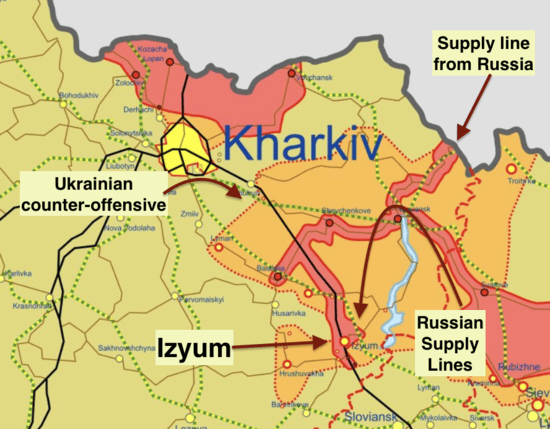Ukraine update: Ukrainian artillery chips away at Russian forces as spring mud season arrives
This post was originally published on this site
Heavy rains have arrived across the two remaining axes in Ukraine—Kherson in the south and Donbas in the east. And with that, don’t expect much territory to change hands. This Canadian volunteer in the Ukrainian foreign legion is fighting around Kherson.
The rain is going to do a number on Russian morale, already rock bottom.
That Canadian’s unit has night-vision gear, and they do their thing under the cover of darkness. No moon means it’ll be even darker. It’s a great way to degrade Russian equipment and morale, and the weather will certainly contribute, but no territory is changing hands. We’re seeing Ukraine’s core deficiencies in action—it now has the tools to defend itself against Russian attacks, and it can certainly harass the hell out of the enemy, but it lacks the air and heavy armor to go on the offensive against entrenched Russians.
I’m in the “armor is mostly obsolete” camp, but that assumes air superiority and massed artillery. If you can’t take out the big enemy guns from the air, or suppress them from afar, you have to charge them on the ground—and you need armor to make that happen. NATO is definitely talking about it, but dear god, there’s nothing left to discuss. Just f’n do it. Western weapons have already killed and maimed tens of thousands of Russian soldiers as Vladimir Putin stands helplessly by. U.S. Secretary of Defense Lloyd Austin literally released a photo of him video chatting with Ukrainian special forces training in Mississippi on the Switchblade killer drone system. We’re already rubbing their nose in our indirect involvement. There’s not much escalation left in sending more and bigger guns at this point.
Meanwhile, out east, guess what Russia did? Yup. The same ineffective shit they’ve been doing. Drip-drip-drip attacks with one to two battalion tactical groups (BTG) because they are unable to turn on the full spigot and attack en masse.
The enemy tried to launch an attack in the directions of Dovgenke and Dmytrivka settlements with the forces of two battalion tactical groups, without success and returned to previously occupied positions.
Russia repeated this doomed and wasteful approach in three other places. This is what I just can’t square—we know Russia is massing its troops in the region, but if they really planned one major all-out assault, why are they willfully feeding men and equipment to the Ukrainian wood chippers today, instead of resting those soldiers, servicing their equipment, resupplying them, and planning something that might actually work. Given Russia’s inability to deploy more than a small number of BTGs at any given time, is this the future of this front? A handful of daily “probes” every day until Russia burns through all their BTGs or Ukraine runs out of anti-tank missiles, whichever comes first?
The rains over the next week will make a muddy mess of the battlefield, swallowing any vehicle stupid enough to go off road. Artillery won’t be affected however. A clever ambush would drop a few random artillery shells in front of a convoy, wait for the vehicles to veer into those muddy fields in a panic, and then helpfully take them off Russia’s hands, intact, for Ukrainian army requisition. Tractors would be helpfully standing by.
The mud will make it even easier for this kind of raid by Ukrainian special forces.
That’s the sanitized, cropped version of those pictures. Others show a field littered with Russian corpses. However, it’s dubious the entire BTG was eliminated. On paper, they have 10 tanks, 40 infantry fighting vehicles, and 800-1,000 soldiers. On the other hand, given how undermanned these BTGs seem, maybe a couple dozen corpses was truly all that was left of that unit.
Regardless, if Russian armored vehicles are this vulnerable to guerilla-style attacks now, when they have at least some mobility, imagine when they’re unable to move. Men on foot or SUVs, with night-vision goggles in the dark, will have a huge advantage over blind Russians without air or direct artillery support.
As flashy as those special forces raids are, Ukrainian artillery is even more impactful. Remember, Izyum’s supply lines run perilously near Ukrainian-held territory around Kharkiv, within easy artillery range.

That’s a lot of yellow Ukrainian-held territory on the western flank of that supply road down to Izyum, allowing artillery to set up and use both drone-guided and precision-guided munitions to wreak havoc on those roads. Look what artillery managed to do in just the last 24 hours:
This intercepted report from a Russian officer in Izyum says it all: “Once again, I would like to note the very precise work of the Ukrainian artillery and mortars. It is their worth that is the main deterrent. 99 percent of our losses are the result of artillery work. There are no bullet wounds at all.” The same officer begs his superiors to stop “the Syrian experience of traveling in kilometer-long dense columns along the roads.”
Who wants to place bets on whether anyone listens to this guy’s sage advice?
Tuesday, Apr 12, 2022 · 1:04:44 PM +00:00
·
Mark Sumner
Before you ask, there is an online site from the Ukrainian government to sell these stamps. However, as of Tuesday morning in the U.S. that site was so swamped with visitors that it can’t actually operate.
Tuesday, Apr 12, 2022 · 1:08:43 PM +00:00
·
Mark Sumner
A Telegram post from the commander of Ukrainian forces at Kryvyi Rih indicates that Ukraine has retaken “more then 15” villages and towns west of the Dnipro in that area north of Kherson. It also says they are working to restore services, in particular electricity, to the area.
However, it’s not clear exactly which villages are involved or when they were recaptured. Likely these are the cluster of locations reported as being taken by Ukrainian forces last week.
Tuesday, Apr 12, 2022 · 1:11:12 PM +00:00
·
Mark Sumner
Not clear how many people are involved in this unit, but it’s a welcome development.
Tuesday, Apr 12, 2022 · 1:14:28 PM +00:00
·
Mark Sumner
In both Poland and Turkey, Ukrainian refugees have been voluntarily cleaning local parks and roadways to express their gratitude for being allowed into the country, and to make it clear they want to be “good guests.”
